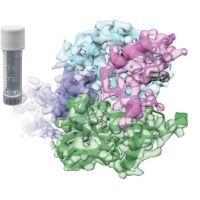Specification
| Organism | Homo sapiens (Human) |
| Expression Host | E.coli |
| Tag Info | N-terminal 6xHis-SUMO-tagged |
| Purity | Greater than 85% by SDS-PAGE |
| Uniprot ID | O60921 |
| Gene Names | HUS1 |
| Alternative Names | Checkpoint protein HUS1; hHUS1; HUS1 (S. pombe) checkpoint homolog; Hus1; HUS1 checkpoint homolog (S. pombe); HUS1 Checkpoint Protein; HUS1 protein; HUS1+ - like protein; HUS1_HUMAN; Hydroxyurea-sensitive 1, S. pombe, homolog of |
| Expression Region | Partial(2-280aa ) |
| Molecular Weight | 47.6 kDa |
| Protein Sequence | KFRAKIVDGACLNHFTRISNMIAKLAKTCTLRISPDKLNFILCDKLANGGVSMWCELEQENFFNEFQMEGVSAENNEIYLELTSENLSRALKTAQNARALKIKLTNKHFPCLTVSVELLSMSSSSRIVTHDIPIKVIPRKLWKDLQEPVVPDPDVSIYLPVLKTMKSVVEKMKNISNHLVIEANLDGELNLKIETELVCVTTHFKDLGNPPLASESTHEDRNVEHMAEVHIDIRKLLQFLAGQQVNPTKALCNIVNNKMVHFDLLHEDVSLQYFIPALS |
| Form | Liquid or Lyophilization |
| Buffer | The default storage buffer is Tris/PBS-based buffer, 5%-50% glycerol if the delivery form is liquid. The lyophilization buffer is Tris/PBS-based buffer, 6% Trehalose, pH 8.0 if the delivery form is lyophilized powder. Please contact us if you have any special requirment. |
| Reconstitution | Please reconstitute protein in deionized sterile water and we recommend that briefly centrifuge thevial prior to opening the vial .We recommend aliquot for long-term storage at -20℃/-80℃. |
Background
| Relevance | Component of the 9-1-1 cell-cycle checkpoint response complex that plays a major role in DNA repair. The 9-1-1 complex is recruited to DNA lesion upon damage by the RAD17-replication factor C (RFC) clamp loader complex. Acts then as a sliding clamp platform on DNA for several proteins involved in long-patch base excision repair (LP-BER). The 9-1-1 complex stimulates DNA polymerase beta (POLB) activity by increasing its affinity for the 3'-OH end of the primer-tplate and stabilizes POLB to those sites where LP-BER proceeds; endonuclease FEN1 cleavage activity on substrates with double, nick, or gap flaps of distinct sequences and lengths; and DNA ligase I (LIG1) on long-patch base excision repair substrates. The 9-1-1 complex is necessary for the recruitment of RHNO1 to sites of double-stranded breaks (DSB) occurring during the S phase. |
| Involvement in Disease | |
| Subcellular Location | Nucleus, Cytoplasm, cytosol |
| Protein Families | HUS1 family |
| Tissue Specificity | HUS1 |
QC Data
| Note | Please contact us for QC Data |
| Product Image (Reference Only) |  |

